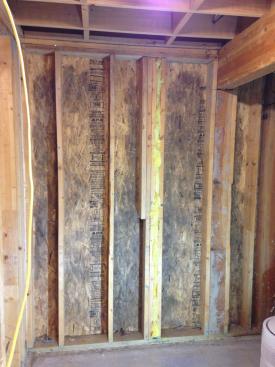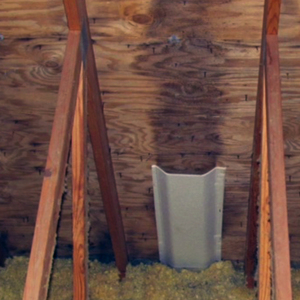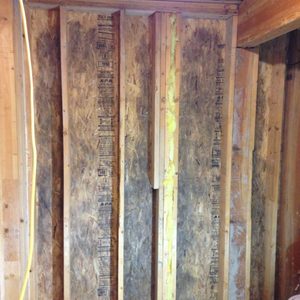
Image Credit: Brian Lent
Brian Lent has discovered something in his walls that no homeowner wants to see: mold.
Preparing a ground-floor room for drywall, Lent pulls some fiberglass batt insulation from a 2×6 stud cavity and notices the back side of the OSB sheathing is damp. A moisture meter reveals that in 80% of the bay, the moisture content is 66% or higher. Moisture and mold are heaviest at the bottom of each bay.
“Interestingly,” he writes in a Q&A post at GreenBuildingAdvisor, “after a panicked weekend a few days ago thinking we had an exterior leak, and much research on the internet and from GreenBuildingAdvisor, came to the consensus that it’s a cold sheathing condensation problem.”
His house is in the hills of Seattle, where winters are slightly colder than they would be downtown. The 400-square-foot room in which Lent is working is really a half-basement. It had been left unfinished and was serving as a mechanical room for HVAC equipment, including a furnace with an attached humidifier, and two gas hot-water heaters along with two 8-inch duct supplying outside air. He also discloses that he’s been running a humidifier during the winter to make indoor air more comfortable.
His remediation plan, already underway, includes killing the mold with a disinfectant, drying out the materials with heat and dehumidification, and then reinstalling the R-19 batts. He’ll finish the walls with mold-resistant drywall, a primer, and two coats of latex paint.
Is he on the right track? Or is there something missing from this equation? That’s the focus of this Q&A Spotlight.
The humidifier is a big mistake
Indoor relative humidity in his area should average about 30% at 70 degrees F during the winter, writes Dana Dorsett. “The only way you would ever need to add humidity…
Weekly Newsletter
Get building science and energy efficiency advice, plus special offers, in your inbox.

This article is only available to GBA Prime Members
Sign up for a free trial and get instant access to this article as well as GBA’s complete library of premium articles and construction details.
Start Free TrialAlready a member? Log in














14 Comments
on the RH% subject..
I have noticed a growing mass of malinformed homeowners thinking that low RH% is bad for health.
Problem is they are seeking 40-50% RH during winter time, which is obviously not necessary at all.
There is no problem associated with 30-35%RH @ 20c and human health.
RH% and homeowning is another thing that should be teached at schools to the 12-16old
to prepare them for their life.
I have yet to see a "recent" house go down below 25%RH during winter time if it kept @ ~21c .
If i recall correctly, 20%RH starts posing health concerns @ ~12c ?? but who wants 12c .
So prepare for more " humidifier" "desastres" in the coming years.
Seems to me like an option
Seems to me like an option would have been to use some "hipster membrane" that acts as an air barrier, and fill the bay behind it with high density cellulose.
Response to Alexandre Richer
Alexandre,
Filling the stud bays with an air-permeable insulation, as you suggest, will not address the underlying problems. And experience shows that an interior membrane is insufficient to prevent the moisture in a home's interior air from reaching the cold side of a wall assembly.
Here's one way to look at it: the air between the pieces of cellulose is interior air, not magic dessicated air. That air contains moisture, and it is in contact with the sheathing.
Moreover, changes in temperature create a pumping action which results in air exchange between the interior and the air between the studs. On cold nights, the air between the studs contracts, and on hot afternoons, the air between the studs expands. Your "hipster membrane" will not prevent this pumping action, which tends to bring more interior air (and therefore moisture) into the stud bays.
The remedy, as I suggested before, is (a) to lower the indoor relative humidity by getting rid of the humidifier, (b) to allow the sheathing to dry, and (c) to create an exterior air barrier against the sheathing with closed-cell spray foam.
Response to Martin Holladay
Martin,
Regarding your points in post #3:
I am not sure what Alexandre meant by “hipster membrane.” If he was referring only to a netting to hold the cellulose, I can understand why that would not solve the moisture problem. But if he was referring to a smart vapor retarder, why wouldn’t that prevent the vapor from condensing on the cold sheathing by simply preventing the vapor from entering the wall in the first place? Or; why wouldn’t the airtight drywall technique solve the problem? It would eliminate the air leaks transporting vapor into the wall cavity and the effect of diffusion would not be significant enough to matter.
I agree that the main cause of the problem experienced by Brian Lent is excess indoor humidity. Secondarily, as I understand it, he also had no drywall or vapor retarder installed as the problem developed. In reading his planned remedy, I don’t see that reducing the humidity is part of it. He mentions his plan to finish with mold resistant drywall that is primed and painted with two coats of latex paint.
I would add to that prescription, the reduction of indoor humidity and a smart vapor retarder properly installed between the studs and the drywall. An alternative to the vapor retarder would be airtight drywall. If I had to choose one or the other, I would choose the vapor retarder, but I would also make the drywall nearly airtight as a matter of course. I don’t see mold resistant drywall or painting as being part of the solution in dealing directly with vapor transmission and wetting.
Response to Ron Keagle
Ron,
Brian Lent's wall is a mess. He wants to fix the wall once and for all, so that when it is all buttoned up, he doesn't have to worry about the problem recurring. This is not a situation that calls for half-measures.
The most important moisture transport mechanism at work here is air leakage. If the new drywall is installed using the Airtight Drywall Approach, that will go a long ways towards solving the problem, as you suggest. But it still leaves cold OSB sheathing, and Brian Lent doesn't want to see any moldy OSB again.
So while it is possible -- perhaps even probable -- that cellulose plus the Airtight Drywall Approach might solve this problem, I still advise Brian to invest in spray foam. The spray foam will stop air leakage and warm up the first condensing surface in the stud bays. The foam will help Brian sleep at night.
Hipsterism.
By "hipster membrane" I do mean the "smart", usually European, vapour retarders like those sold by foursevenfive in Brooklyn and Small Planet Workshop in Washington State. I agree that spray foam will provide better peace of mind in this instance.
Response to Alexandre Richer
Alexandre,
"Hipster membrane" is useful shorthand. I may adopt the term. Thanks.
Smart vapor barriers are fairly vapor open at 50% RH
The wintertime humidity isn't super-low in that climate, and if they continue to actively humidify to 50% relative humidity a smart vapor retarder would be no more vapor retardent than latex paint. Only when the RH is under 35% does it drop to class-II vapor retardency. Smart vapor retarders CAN be used to good effect in that region, but not in actively humidified homes.
This experimental test done by Washington State University at their Puyallup WA test facility (southern Puget Sound region) demonstrates the efficacy of Certainteed MemBrain in that climate:
http://www.energy.wsu.edu/documents/AHT_ComparingTheMoisturePerformance%20Of%20Wood%20Framed%20Wall%20Systems.pdf
Confused
This subject has really piqued my curiosity. I've always been told that the reason to humidify is because winter air, being colder, is drier and that heating dries it out further.
I do not humidify because I agree that it's a bad idea, but the people I know who do use a humidifier do so because they are suffering from dry skin, chapped lips, and breathing problems like asthma, that are aggravated by drier air. I know that parents of infants are often advised by doctors to humidify, particularly during bouts with respiratory infections. Can you explain further about this issue?
Response to L.H.
L.H.,
There are two components to your question:
1. Does dry indoor air really cause medical problems?
2. What is the best way to raise indoor relative humidity during the winter?
On the first question, I defer to medical professionals. Here's my perspective, however: dry air irritates some, but not all, people. Remember, the outdoor air in a desert climate is often extremely dry, and people have been living in these types of climates for tens of thousands of years. Many Americans move to the Southwest because the dry air is said to be good for their health.
On the second question, here's my advice: if the indoor relative humidity (RH) in your home is too low during the winter, the solution is to seal the air leaks in your home. If you try to solve the problem by installing a humidifier, you risk causing moisture damage to your home.
Leaky homes obviously have a high air exchange rate. All of that outdoor air is extremely dry during the winter, so high rates of air infiltration result in low indoor RH. Plug the air leaks, and you will solve the problem.
For more information on the necessary steps, see:
Air Sealing an Attic
Air-Sealing a Basement
Relative humidity set point
Several commenters have suggested that winter time RH should be in the mid-30s. Clearly, keeping RH at that level does help prevent mold growth and prevent condensation on window glass. However, despite what some have said, that level of RH can be unhealthy for occupants of the home, leading to problems such as dry skin, nose bleed, and worsening of asthma symptoms (all of which my wife and I have experienced when the RH has been low). We keep our humidistat set at 45% year round and have found that we don't have any of the symptoms I just cited, nor have we found any mold anywhere in the house. Also, we have found that anything lower than 45% can lead to problems with our antiques and works of art. We have a humidifier on the HVAC return air plenum and we run a portable dehumidifer in the summer when needed. We are located in Northern Virginia.
Controlling Humidity
I would want to build a wall that did not require limiting the indoor humidity for the purpose of preventing wetting inside of the wall cavity. Then I would only limit indoor humidity to the extent needed to avoid window damage.
Heating the air does not dry it out (response to L.H.)
There is nothing about a heating system that removes moisture from the air. Ducted hot air systems can sometimes increase the infilatration rate (unintended ventilation through leaks in your house) which can reduce the moisture levels of the indoor air, but that's an air leak problem (as Martin suggests), not a heating problem.
Taking cold air as some nominal relative humidity and heating it to a higher temp changes it's relative humidity, but that's the "relative" part. At the same moisture content raising the temperature of the air raises the amount of moisture necessary to saturate/condense (100% humidity== fog conditions).
Since human activities such a breathing, bathing, cooking, watering the houseplants etc all contribute moisture to the interior air, in a fully air-tight house moisture levels will rise over time to unhealthful levels (for both you AND the house.) The widely prescribed "healthy" air levels for humans from the medical professionals is 30-50% RH @ 68-75F indoor temps.
But while 50% RH @ 70F is OK for YOU, the "dew point" of that air (the temperature at which it's relative humidity = 100%) is about 51F, which means if your wintertime outdoor temperature averages are in the 40s or lower, the sheathing is colder than the indoor dew point, and can adsorb considerable moisture content even via vapor diffusion through the wall, unless there is a sufficiently vapor retardent layer to control the rate of moisture flow. (Air leaks from the interior are even worse, MUCH worse than vapor diffusion transfer.) If instead you control the interior RH to a limit of 35% @ 70F it's still healthy for the humans, and the dew point is then 41F, which is below the mean wintertime outdoor temps in the Puget Sound area, but still above the wintertime mean temps of climate zone 5 locations.
The solutions for those colder locations is varied. The standard 1980s solution was to put an interior side vapor barrier up, but those have proved problematic in practice due to air-leakage and summertime moisture drives from the exterior (particularly on brick or stucco homes.) Another is to build in a ventilated gap between the siding and sheathing that alone is sufficiently protective for a zone 5 location, since the drying rate toward the exterior mostly keeps up, and when temps are warmer, the drying rate is fairly rapid. Another solution is to add sufficient R value on the exterior of the sheathing to bring the mean temp of the sheathing high enough that it doesn't take on too much moisture. These solutions are now enshrined in IRC building code, broken down by US climate zone:
http://publicecodes.cyberregs.com/icod/irc/2012/icod_irc_2012_7_sec002_par025.htm
But these solutions do NOT all work if you are dumping a ton of moisture into the house, keeping it at 50% RH!
Hipster Membrane?
Perhaps I'm not aware of the age limits involved but I feel to old to be a "hipster".
And Siga Majpell doesn't quite fit the "hip-ness" of the product classification. It's got a low perm rate fixed in Class II (0.68 US Perms). It's the interior high humidity conditions like this one that point out where a Class II fixed rate is really useful.
Hipster or not, Yes, it's the air leakage and not the diffusion that are the most important issue to deal with.
Happy Holidays from The Small Planet Workshop.
Log in or become a member to post a comment.
Sign up Log in